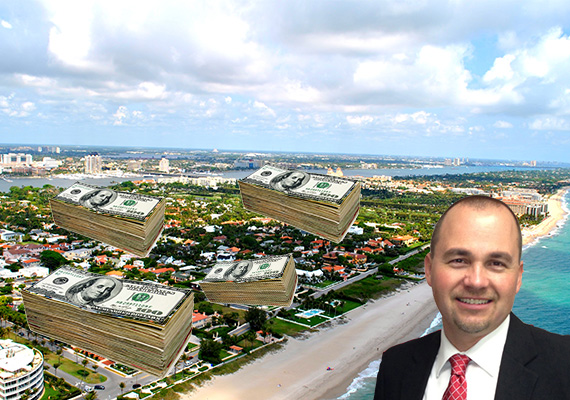The luxury condo markets of Broward and Palm Beach counties look poised to benefit from a new anti-money laundering directive from the U.S. Treasury Department that targets all-cash buyers of “high-end” Miami-Dade residential real estate.
Beginning in March, the Financial Crimes Enforcement Network bureau will begin requiring – on a six-month-trial basis – title insurance companies to determine the identities of all-cash buyers who use third-party entities – or “shell companies” – to acquire residential properties at transaction prices of more than $1 million in Miami-Dade County, as well as the Manhattan Borough of New York City.
No other areas in the United States fall under the reach of the Jan. 13 order that focuses on “combating money laundering in the real estate sector,” according to the FinCEN statement.
The temporary requirement – which some market watchers are speculating may become permanent – does not pertain to Broward and Palm Beach that together with Miami-Dade make up the tri-county South Florida region.
Miami-Dade has historically been a market that appealed to international and domestic buyers alike of luxury residential properties, while Broward and Palm Beach have generally offered cheaper real estate alternatives for more value-oriented investors who tend to reside in the United States.
Anyone familiar with the South Florida region can easily imagine a scenario where the limited geographic scope of the federal order could encourage all-cash buyers who are focused on maintaining their anonymity to travel just north of Miami-Dade to confidentially purchase luxury residential real estate.
No statistics are readily available that currently track the number of allegedly illicit residential real estate transactions in South Florida.
Buyers generally purchase properties in legal entities that disguise their names in hopes of limiting liability and shielding their identities from the public for a variety of reasons, including security concerns and competitive advantages.
All-cash real estate transactions have boomed in the South Florida since the previous cycle, due to increased competition for discounted properties coupled with the challenges in recent years of obtaining mortgages from banks.
In its most recent monthly report released on Dec. 22, the Miami Association of Realtors announced that nearly 55 percent of all Miami-Dade residential resale transactions were conducted by way of “cash deals.” More than two-thirds of condo purchases were transacted in cash deals compared to nearly 40 percent of single-family home sales for the month, according to the report.
Ironically, the Fed’s order targeting Miami-Dade could prove beneficial for the so-called “secret” buyers of luxury South Florida residential properties at this point in the current real estate cycle.
Besides being able to preserve their anonymity by purchasing in Broward and Palm Beach, all-cash buyers of luxury residential real estate could take advantage of the value currently being offered to the north of Miami-Dade.
Consider that the average price per square foot for a condo unit with an asking price of at least $1 million works out to $1,187 in Miami-Dade, $661 in Broward and $948 in Palm Beach, according to data from the Southeast Florida MLXchange.
In 2015, the average transaction price per square foot for a condo that was listed for at least $1 million traded at $918 in Miami-Dade, $552 in Broward and $622 in Palm Beach, according to the data.
Currently, the supply of condos listed as available for purchase at a minimum price of $1 million each stands at nearly 26 months in Miami-Dade, less than 18 months in Broward and about 17 months in Palm Beach.
A balanced market is considered to have a six-month supply of condo units available for purchase. More months of supply suggests a buyer’s market, and less months indicates a seller’s market.
On the preconstruction condo front, the Fed’s announcement comes at a time when the luxury coastal market of Miami-Dade market appears to be reaching its peak while the slower growing markets of Broward and Palm Beach are still gaining momentum. Since this current real estate cycle began in 2011, developers have announced plans to build nearly 260 new condo buildings with more than 36,335 units east of I-95 in Miami-Dade, according to the preconstruction condo projects website CraneSpotters.com. (For disclosure, my firm operates the website.)
By comparison, developers have announced 95 new condo buildings with about 9,030 units in Broward and 62 new buildings with nearly 4,300 units in Palm Beach.
On a year-over-year basis, the South Florida preconstruction condo pipeline of new units increased in 2015 by about 25 percent in Miami-Dade, compared to about 15 percent in both Broward and Palm Beach, respectively.
The unanswered question going forward is whether the new Fed directive will forever change the dynamics of South Florida’s luxury condo market.
Peter Zalewski is a real estate columnist for The Real Deal who founded Condo Vultures LLC, a consultancy and publishing company, as well as Condo Vultures Realty LLC and CVR Realty brokerages and the Condo Ratings Agency, an analytics firm. The Condo Ratings Agency operates CraneSpotters.com, a preconstruction condo projects website, in conjunction with the Miami Association of Realtors.
